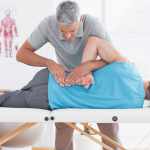Knee pain is a really common problem among older adults and younger athletes. It describes any form of sensitivity affecting the knees. The pain can originate from the knee joint, the kneecap, or the cartilage and ligaments of the knee. The exact location of the pain varies depending on the structure that is involved.
The intensity of the pain can vary from a minor ache to a severe and chronic ache. Understanding the underlying cause of your pain is the first step to being able to treat it and get relief for knee pain.
Knee pain is often accompanied by physical restriction. Other signs and symptoms of knee pain include discomfort that causes limping, difficulty walking, inability to bend or extend the knee, unusual sounds when moving the knee, weakness in the affected leg that makes it hard to bear one’s own weight, redness, stiffness, significant pain, fever, and swelling around the knee.
What are the common causes of knee pain?
Knee pain has many causes ranging from infections to injuries, and complications of medical conditions. Knee pain can develop gradually over time or happen suddenly due to impact.
The most common cause of knee pain is knee injury. However, this does not necessarily mean that you have to get into an accident in order to have an injury. Some potential causes of knee injury are exercises involving repetitive movements such as running that can rupture ligaments or tear cartilage.
Other common causes of knee pain are rheumatoid arthritis, osteoarthritis, gout, fat pad irritation, deformities that cause the kneecap to fall off, dislocation of the knee joint, bone break off, and infections that cause fluid retention and swelling.
What are the risk factors for knee pain?
The knee joint is frequently used throughout the day; any abrupt change in movement can result in injuries and pain.
Knee pain can be aggravated by physical activity and obesity. Certain exercises such as skiing or jogging may lead to overuse of the joint which causes pain. Excess weight puts too much pressure on the knee joint and causes the cartilage to break down more rapidly.
Other lifestyle habits that put one at risk of knee pain include engaging in risky sports such as rugby, being an endurance cyclist, weight lifting that involves poor posture, and workouts that have inadequate rests in-between.
What is the diagnosis of knee pain?
Normally, knee pain occurs for short periods and then resolves. If you have knee pain that doesn’t disappear in a couple of days or that which does not respond to rest, you need to see a doctor. Talk to him about all the symptoms that you experience and answer any questions that you’re asked.
A thorough physical examination by your doctor is necessary to establish the type and cause of the pain. The exam will help him see how your leg responds to different movements.
When the doctor needs to do further tests, a blood test, CT scan, X-ray, ultrasound, or MRI may be required to confirm a diagnosis.
The treatment for knee pain
Regardless of what causes knee pain, there are many treatments that work. The treatment varies depending on the cause of the pain. Doctors first look at the patients’ symptoms, lifestyle, and exercise habits then they can know how to treat knee pain. Some of the recommended treatments for knee pain include:
- Medication
Patients can either take over-the-counter or prescribed medications for pain relief and treat underlying medical conditions respectively. It’s, however, not advisable to take OTC drugs for prolonged periods. One ought to visit a doctor for proper diagnosis and to avoid the potential side effects associated with chronic medication use.
In some situations, there are some medicines that are injected directly into the knee to help with arthritis and other inflammations of the knee.
- Massage
Massage relieves knee pain; it works by relaxing the muscles around the knee and thigh areas. It also boosts the flow of blood and helps ease inflammation.
Massaging should be done for at least 5 minutes, twice a day. The patient should be seated with his/her feet flat on the floor and the knees pointing forward.
- Exercise and Physical Therapy
Physical activity helps strengthen the muscles around the knee making it more stable. This prevents further worsening of the injury and guarantees easy movements.
Ideal exercises include swimming and water aerobics, elliptical training, yoga, and cycling. Avoid activities like jumping and intensive biking that may negatively impact your knees.
It’s highly recommended to work with a professional physical therapist; he’ll help you build strength in your lower body. You should also take breaks to allow your body enough time to rest and heal.
- Foam Rolling
This technique is really helpful in breaking up adhesions that cause knee pain. Patients who have discovered the magic of foam rolling have reported significant improvement and relief for knee pain.
Foam rolling helps increase flexibility and loosen tight muscles around the knee joint. Foam rolling is recommended for the quadriceps, hamstring, and the IT band.
- PRICE
The abbreviation stands for protection, rest, ice, compression, and elevation.
Protection and rest prevent your knee from any further injury while ice, compression, and elevation help relieve pain and treat knee pain that results from soft tissue injury.







